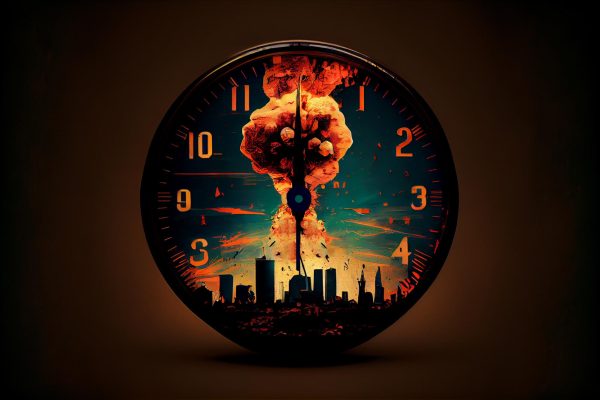
Recently, the Bulletin of the Atomic Scientists announced that they would be setting the Doomsday Clock at 90 seconds to midnight, the closest it has ever been to signaling a metaphoric “doom” for humanity.
Even though the clock’s messaging may mean that we are approaching the end of the world as we know it, the sense of urgency that this symbol is supposed to instill is just not there. With little variation in the underlying reasons for these clock shifts, it has led myself and numerous others to become desensitized to any sense of urgency that its symbolism is supposed to signify. The Bulletin should include more diverse perspectives on global issues and perhaps, discuss in detail, how ordinary citizens can work to address said issues.
The Doomsday Clock was established in 1947 by the Bulletin as a way to represent how close humanity is to destruction by our own hands. At that time, the nuclear conflict served as the biggest concern for doomsday; today, that list has grown to include climate change, biological threats and implications of new technologies.
In 2012, the Doomsday Clock was set at five minutes to midnight. In 2015, the minute hand jumped forward to three minutes to midnight. During the pandemic in 2020, the clock loomed at 100 seconds till 12 a.m.
As evident from this trend, humanity is supposedly moving closer and closer to annihilation. The reasons cited by the Bulletin have been ubiquitous throughout the years, such as nuclear tensions, climate change and — in recent times —biological threats.
The board highlighted several reasons for the most recent setting of the clock, and, you guessed it: nuclear conflict, climate change and, uniquely, the rise of artificial intelligence (AI) were the causes provided.
While these issues have been experiencing a downward trajectory throughout the decade, the repetitive use of these grounds for signaling the end of the world has made the Doomsday Clock seem monotonous in nature.
Studies have shown that repeated exposure to something that initially invoked a negative response will likely reinforce these negative attitudes. People want to hear that the world’s problems, if not improving, are at least shifting. Highlighting the same issues year after year would cause the public to view the changing of the clock as a loop.
Without an index that offers a quantitative value to each global issue cited by the Bulletin, it is difficult to compare their severities throughout the years in an objective manner.
For instance, in 1953, the Doomsday Clock was set at two minutes until midnight; it was the year that both the US and the USSR tested their first hydrogen bombs. In 2018, the clock was also at two minutes till midnight, to which the Bulletin cited the Trump administration’s provocative relationship with North Korea and unwillingness to take action against climate change.
Although both years were arguably some of the worst in modern history, it’s hard to gauge in relativity how close humanity was to doom. Opinions and perspectives can only get us so far; an index grounded in mathematics and logic, such as the European Commission’s INFORM Severity index, which measures the severity of humanitarian crises worldwide, and ACLED Conflict Index, would allow us to better compare the severity of global events.
Despite the clock’s inability to accurately determine how close we are to doomsday, its intended purpose of alerting the public of how close we are to doom is genuine and more important than ever.
There has been an increasing amount of relevance when considering the power of nuclear energy, especially with the ongoing war in Ukraine and Gaza, which has pulled the plug on many U.S. diplomatic relations with countries such as Russia and China. In addition, 2023 holds the record for the warmest year globally, a sign that climate change is worsening. The rise of AI, such as the infamous ChatGPT software, has led many to question the implications of such advanced technology.
Even though the answer to the question “Is humanity really approaching its end?” is convoluted, and the answer is a “maybe” at best, the world’s problems are not going away. World leaders will have to work collectively to address these issues — and do so promptly — if we have any hope in turning back the Doomsday Clock.
If powerful countries such as the U.S., Russia and China would put aside their rivalry to focus on the bigger issue at hand, perhaps in another decade, the answer to the aforementioned question would be a definitive “no”.
Additionally, if the Bulletin were to emphasize the ever-changing dynamics of world issues, using tactics such as highlighting different perspectives or novel details, it would be easier to captivate the attention of the public. Engaging the public to actually care about these issues is crucial to lobbying the people in power who can enact realistic change.












